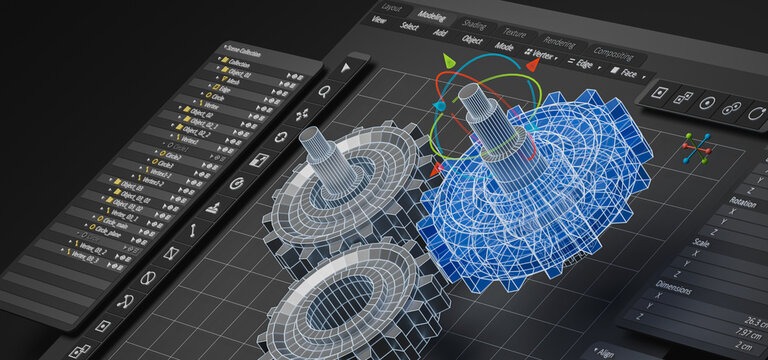Introduction 🌱
In today’s competitive engineering landscape, mastering CAD (Computer-Aided Design) software is essential for anyone working in mechanical design. CAD software enables engineers and designers to create precise 2D and 3D models, optimize designs, and streamline the manufacturing process. Whether you’re designing automotive parts, industrial machinery, or consumer products, proficiency in CAD can significantly enhance your productivity, creativity, and career prospects. This article explores practical strategies to master CAD software and gain a competitive edge in mechanical design.
What Is CAD Software? 🤔
CAD software is a digital tool that allows engineers and designers to create, modify, and analyze detailed drawings and 3D models of mechanical components and assemblies. Unlike traditional drafting methods, CAD software improves accuracy, speeds up design iterations, and enables seamless collaboration.
Popular CAD software used in mechanical design includes:
- AutoCAD 🏗️: Widely used for 2D drafting and 3D modeling.
- SolidWorks 🧩: Known for its intuitive interface and parametric modeling capabilities.
- Fusion 360 🌐: Cloud-based software that integrates CAD, CAM, and CAE tools.
- CATIA ✈️: Used in aerospace, automotive, and complex mechanical design.
- Creo (formerly Pro/ENGINEER) ⚙️: Ideal for product design and simulation.
- Siemens NX 🚗: Comprehensive software for advanced engineering and manufacturing.
Benefits of Mastering CAD Software ✅
Mastering CAD software offers numerous benefits that can give you a competitive advantage in mechanical design:
- Enhanced Design Precision 🎯: Create detailed and accurate models with tight tolerances.
- Increased Productivity ⚡: Speed up design processes and reduce time-to-market.
- Improved Collaboration 🔗: Share and collaborate on designs with teams and clients.
- Seamless Prototyping 🧩: Generate digital prototypes and simulate real-world conditions.
- Cost Savings 💸: Reduce material waste and production errors through virtual testing.
- Career Advancement 📈: Boost your resume and stand out in the job market.
Key Skills to Master in CAD Software 🧠
1. Understanding the User Interface (UI) 🖥️
Familiarize yourself with the software’s user interface, including toolbars, menus, command prompts, and shortcuts. Efficient navigation improves your workflow and productivity.
2. Creating 2D Drawings ✍️
Learn how to create accurate 2D sketches using lines, circles, arcs, and dimensions. Mastering 2D drawings is essential for developing technical blueprints and layouts.
3. Building 3D Models 🧩
Understand how to create 3D models using extrusion, revolution, lofting, and sweeping techniques. Focus on parametric modeling, which allows you to make design changes quickly by adjusting dimensions and constraints.
4. Assembly Design 🔗
Master the process of assembling multiple components into a complete product. Learn to define relationships, constraints, and motion between parts, ensuring that your design functions correctly.
5. Simulating and Analyzing Designs 📊
Use simulation tools to test your designs for stress, heat, motion, and fluid flow. Analyzing these factors helps optimize performance and durability before manufacturing.
6. Generating Technical Drawings 📝
Convert your 3D models into detailed technical drawings with annotations, dimensions, and exploded views. These drawings are essential for manufacturing and quality control.
7. Using Advanced Features 🧠
Explore advanced features like surface modeling, sheet metal design, and generative design. These tools enable you to create complex shapes and lightweight structures with high strength-to-weight ratios.
Strategies to Master CAD Software 🚀
1. Choose the Right CAD Software 💻
Select the CAD software that best suits your industry and career goals. For example:
- Use SolidWorks or Fusion 360 for product design and mechanical engineering.
- Choose AutoCAD for 2D drafting and architectural projects.
- Opt for CATIA or Siemens NX for aerospace and automotive design.
2. Learn the Basics First 📚
Start with the basics, such as creating simple shapes, using constraints, and applying dimensions. Build a strong foundation before moving on to advanced features.
3. Practice Regularly 🏗️
Consistent practice is key to mastering CAD software. Work on personal projects, replicate existing designs, and challenge yourself with increasingly complex models.
4. Take Online Courses and Tutorials 📺
Leverage online resources such as video tutorials, webinars, and courses from platforms like Coursera, Udemy, and LinkedIn Learning. Some popular courses include:
- “Learning AutoCAD” on LinkedIn Learning
- “SolidWorks Essential Training” on Udemy
- “Fusion 360 for Beginners” on Autodesk University
5. Join CAD Communities and Forums 🌍
Join online communities like GrabCAD, Autodesk Forums, and SolidWorks User Groups to connect with other designers, share your work, and seek advice on challenging projects.
6. Learn Keyboard Shortcuts ⌨️
Mastering keyboard shortcuts can significantly speed up your workflow. For example:
- AutoCAD: Use “L” for line, “C” for circle, and “TR” for trim.
- SolidWorks: Use “S” for the shortcut bar and “Ctrl + 8” for normal view.
- Fusion 360: Use “P” for project, “Q” for press-pull, and “E” for extrude.
7. Understand Design for Manufacturing (DFM) 🧩
Learn to design components that are easy and cost-effective to manufacture. Consider factors like material properties, tolerances, and production methods (CNC machining, injection molding, 3D printing).
8. Use Simulation and Analysis Tools 📊
Explore simulation tools within your CAD software to test how your designs will perform under real-world conditions. For example:
- Use SolidWorks Simulation to analyze stress, strain, and thermal effects.
- Use Fusion 360 Simulation to optimize material usage and structural strength.
9. Stay Updated with New Features 📢
CAD software is constantly evolving, with new features and tools released regularly. Stay updated by reading software release notes, attending webinars, and participating in user conferences like SolidWorks World and Autodesk University.
10. Build a Strong Portfolio 📁
Create a portfolio showcasing your best CAD projects, including detailed renderings, assembly models, and technical drawings. A well-structured portfolio demonstrates your skills to potential employers and clients.
Common Mistakes to Avoid ❌
- Ignoring Constraints and Dimensions: Always apply constraints and dimensions to ensure your designs are accurate and easy to modify.
- Overcomplicating Models: Keep your designs as simple as possible to reduce file size and improve performance.
- Neglecting File Management: Organize your files using clear naming conventions and version control to avoid confusion.
- Skipping Simulations: Test your designs using simulation tools to identify potential issues before manufacturing.
- Relying Only on Tutorials: While tutorials are helpful, challenge yourself with real-world projects to develop practical skills.
Real-World Applications of CAD Software 🌍
CAD software is used across various industries to design and optimize mechanical components and systems:
- Automotive 🚗: Designing engines, chassis, and aerodynamic components.
- Aerospace ✈️: Creating lightweight, high-strength components for aircraft and spacecraft.
- Consumer Products 🧩: Developing ergonomic and aesthetically pleasing products.
- Medical Devices 🏥: Designing surgical instruments, prosthetics, and implants.
- Electronics 💻: Creating enclosures, connectors, and circuit board layouts.
- Architecture and Construction 🏗️: Designing HVAC systems, structural components, and building layouts.
The Future of CAD in Mechanical Design 🚀
As technology advances, CAD software is becoming more powerful and accessible. Future trends include:
- AI-Powered Design 🤖: Using artificial intelligence to generate optimized designs and automate repetitive tasks.
- Cloud-Based Collaboration 🌐: Enabling teams to collaborate on designs in real-time from anywhere in the world.
- Augmented and Virtual Reality (AR/VR) 🕶️: Visualizing and interacting with 3D models in immersive environments.
- Generative Design 🧠: Using algorithms to explore thousands of design possibilities and select the best options.
- Integration with Manufacturing 🏭: Seamlessly connecting CAD software with CNC machines, 3D printers, and other manufacturing equipment.
Conclusion 🌟
Mastering CAD software is essential for anyone seeking a competitive edge in mechanical design. By developing your skills in 2D drafting, 3D modeling, assembly design, and simulation, you can create innovative products with precision and efficiency. Regular practice, online courses, and real-world projects will help you stay ahead of the curve. As CAD technology continues to evolve, embracing new tools like AI, cloud collaboration, and generative design will further enhance your capabilities, positioning you for success in the ever-changing world of mechanical engineering.


